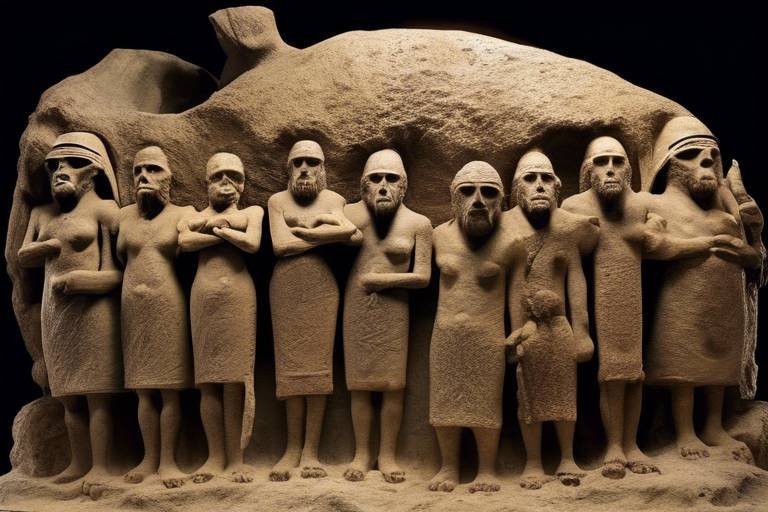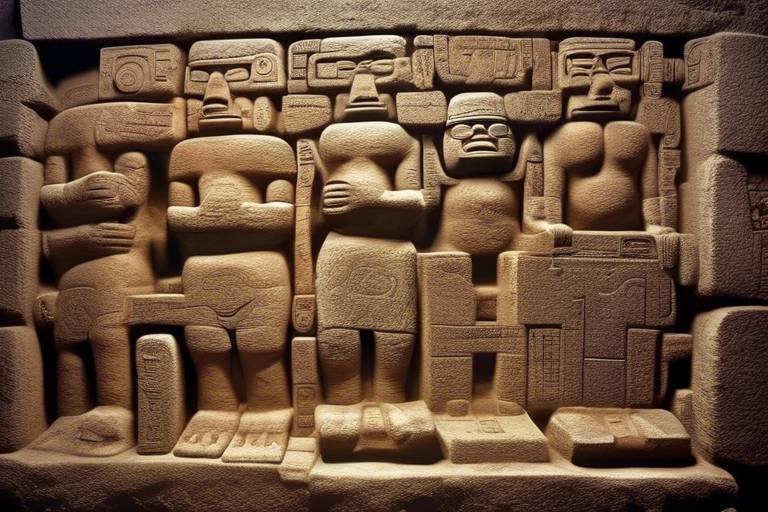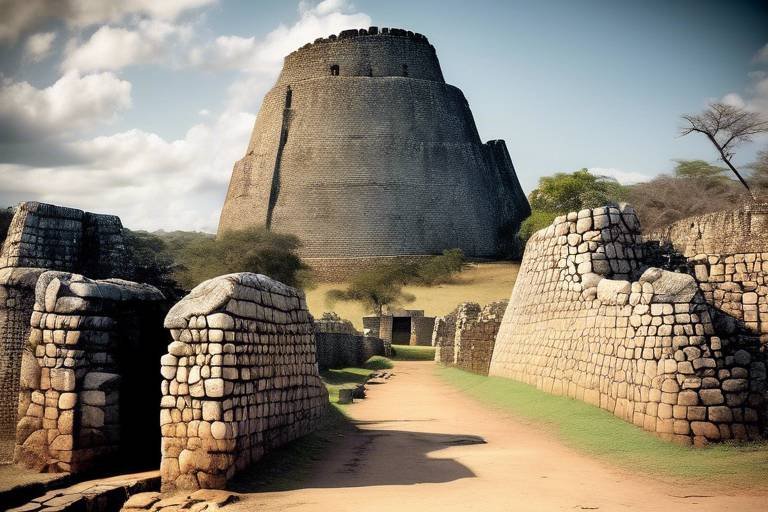The Forgotten Civilizations of the Near East
The Near East is a region rich in history, filled with ancient civilizations that have often been overlooked in favor of more well-known societies. While names like the Egyptians, Greeks, and Romans dominate our historical narratives, there are numerous other cultures that made significant contributions to the development of human civilization. Let's embark on a journey to uncover the hidden gems of the Near East, exploring the lesser-known but equally fascinating civilizations that once thrived in this region.

The Elamite Civilization
The Elamite Civilization was a fascinating society that thrived in what is now southwestern Iran. Known for their advanced art and culture, the Elamites had a unique language that set them apart from their neighbors in Mesopotamia. Their interactions with the Mesopotamians influenced both civilizations, leading to the exchange of ideas and technologies.
One of the most remarkable aspects of the Elamite Civilization was their intricate artwork, which showcased their artistic skills and cultural sophistication. Their pottery, metalwork, and architecture reflected a high level of craftsmanship and creativity. The Elamites also excelled in the production of jewelry, using precious metals and gemstones to create stunning pieces.
Despite being overshadowed by the more well-known Mesopotamian civilizations, the Elamites played a significant role in the ancient Near East. Their strategic location allowed them to control important trade routes, facilitating economic exchanges with distant regions. This economic prosperity contributed to the cultural development and political stability of the Elamite society.
Furthermore, the Elamites engaged in diplomatic relations with neighboring empires, such as the Babylonians and Assyrians. These interactions led to alliances and conflicts that shaped the political landscape of the region. The Elamites were known for their resilience in the face of external threats, demonstrating their military prowess and strategic acumen.
Overall, the Elamite Civilization left a lasting legacy in the Near East, influencing subsequent cultures and societies. By exploring the rich history and achievements of the Elamites, we gain a deeper understanding of the complexity and diversity of ancient civilizations in the region.

The Hittite Empire
The Hittite Empire, a formidable power that rose to prominence in Anatolia, present-day Turkey, left a lasting impact on the ancient world. Known for their military prowess and strategic diplomacy, the Hittites navigated a complex geopolitical landscape, forging alliances and engaging in conflicts that shaped the region's history.
At the heart of the Hittite Empire lay Hattusa, its capital city renowned for its impressive fortifications and administrative structures. The Hittites excelled in the art of warfare, employing advanced tactics and weaponry that allowed them to expand their territory and influence across Anatolia and beyond.
One of the defining features of the Hittite Empire was its sophisticated diplomatic relations with neighboring states. Through strategic marriages, alliances, and treaties, the Hittites maintained a delicate balance of power in the region, ensuring stability and prosperity for their empire.
Furthermore, the Hittites made significant contributions to the ancient world through their advancements in metallurgy, agriculture, and architecture. Their use of iron weapons revolutionized warfare, while their innovative agricultural techniques boosted food production and supported a growing population.
Archaeological discoveries have revealed the grandeur of the Hittite Empire, with magnificent temples, palaces, and monuments showcasing their rich cultural heritage. The Hittites' legacy as a major player in the Near East continues to fascinate historians and archaeologists, shedding light on a civilization that once rivaled the great powers of the ancient world.

The Mitanni Kingdom
The Mitanni Kingdom was a fascinating Hurrian-speaking state that thrived in northern Mesopotamia and Syria during the 2nd millennium BCE. Known for their skilled charioteers and diplomatic prowess, the Mitanni people established a powerful kingdom that played a significant role in the geopolitics of the ancient Near East.
One of the key aspects of the Mitanni Kingdom was its religious practices, which often involved the worship of deities such as the storm god Teshub. The kingdom's governance was structured around a monarchy, with a king at the helm who wielded considerable authority over the state's affairs.
Cultural exchanges were also a prominent feature of Mitanni society, with influences from neighboring civilizations such as Egypt and Babylon shaping their art, language, and customs. This intermingling of cultures contributed to the richness and diversity of the Mitanni Kingdom.
Trade played a vital role in the prosperity of the Mitanni Kingdom, with the state benefiting from its strategic location along major trade routes. The kingdom's wealth and resources were bolstered by its control over lucrative trade networks that connected the Near East with distant lands.
Despite its achievements, the Mitanni Kingdom eventually faced challenges from rival powers such as the Hittites and the Assyrians, leading to its eventual decline and absorption into other empires. The legacy of the Mitanni people, however, lives on through archaeological discoveries and historical records that offer glimpses into their once-thriving civilization.

The Urartu Civilization
The Urartu Civilization, also known as the Kingdom of Van, was a powerful civilization that thrived around Lake Van in eastern Anatolia. Known for their impressive fortresses, the Urartians built massive stone structures to protect their cities and exert control over the region. These fortresses, such as the famous fortress of Van, showcased their advanced engineering skills and strategic military planning.
One of the most remarkable aspects of the Urartu Civilization was their sophisticated irrigation systems. The Urartians were adept at managing water resources, utilizing canals and reservoirs to support agriculture in their mountainous homeland. This mastery of irrigation allowed them to cultivate fertile lands and sustain a thriving economy.
The Urartian language, known as Urartian, remains a mystery to modern scholars. Despite efforts to decipher the script, much of their written records are still not fully understood. This unique language reflects the distinctive cultural identity of the Urartu people and highlights the complexity of their society.
Trade played a significant role in the prosperity of the Urartu Civilization. Situated at the crossroads of major trade routes, the Urartians engaged in commerce with neighboring regions, exchanging goods and ideas. Their participation in trade networks facilitated cultural exchanges and contributed to the richness of their material culture.
Religion was an integral part of Urartian society, with temples and religious practices central to their daily life. The Urartians worshipped a pantheon of deities, with rituals and ceremonies conducted to honor and appease the gods. These religious beliefs shaped their worldview and influenced their artistic expressions.

The Phoenician City-States
The Phoenician City-States were a collection of independent city-states located along the eastern coast of the Mediterranean Sea. These city-states, including prominent ones like Tyre, Sidon, and Byblos, were known for their maritime prowess and extensive trade networks that spanned the ancient world.
The Phoenicians were skilled sailors and traders, navigating the seas to establish lucrative trade routes with regions as far as Egypt, Greece, and Spain. Their mastery of shipbuilding and navigation allowed them to dominate the Mediterranean trade scene, exporting goods such as cedar wood, textiles, glassware, and purple dye.
One of the most significant contributions of the Phoenician City-States was the development of the Phoenician alphabet, a writing system that served as the basis for many modern alphabets, including Greek and Latin. This innovation revolutionized communication and literacy in the ancient world, paving the way for the spread of knowledge and ideas.
Furthermore, the Phoenicians were known for their religious practices, worshiping a pantheon of deities and engaging in rituals and ceremonies to honor their gods. Their cosmopolitan society welcomed diverse cultural influences, leading to a rich tapestry of beliefs and traditions within the city-states.
Despite their small size, the Phoenician City-States wielded significant influence in the ancient world, playing a crucial role in shaping the cultural, economic, and political landscape of the Near East. Their legacy endures through their innovations, trade networks, and enduring impact on subsequent civilizations.

The Nabateans of Petra
Journey to the ancient city of Petra and uncover the fascinating civilization of the Nabateans. Nestled in the rocky desert terrain of modern-day Jordan, the Nabateans were renowned for their mastery of rock-cut architecture and intricate trade routes that connected the Arabian Peninsula with the Mediterranean world. The city of Petra itself is a testament to their engineering skills, with elaborate structures carved directly into the rose-red cliffs.
One of the most remarkable features of the Nabateans was their advanced water management systems. Despite the arid environment, they developed sophisticated methods to collect and channel water, allowing them to thrive in the desert landscape. The ingenious use of dams, cisterns, and aqueducts enabled the Nabateans to support a flourishing urban center at Petra.
Religion played a significant role in Nabatean society, with a pantheon of deities worshipped in temples and sanctuaries throughout their territory. The Nabateans also practiced intricate burial rituals, with elaborate tombs carved into the rock faces serving as final resting places for the deceased.
Trade was vital to the Nabatean economy, and their strategic location at the crossroads of major trade routes allowed them to amass wealth and influence. The Nabateans controlled key caravan routes that facilitated the exchange of goods such as spices, incense, and precious metals between the East and the West.
The Nabateans left behind a rich legacy that continues to captivate archaeologists and historians to this day. Their unique blend of architectural innovation, hydraulic engineering, and commercial acumen set them apart as a remarkable civilization that thrived amidst the harsh desert environment of Petra.

The Sumerians of Southern Mesopotamia
The Sumerians of Southern Mesopotamia were the pioneers of civilization in the region, laying the groundwork for future empires to flourish. Their innovative spirit and ingenuity propelled them to create remarkable advancements that shaped the course of history.
One of the most notable contributions of the Sumerians was the development of the world's first known writing system, known as cuneiform. This intricate script, etched into clay tablets with wedge-shaped characters, enabled the recording of transactions, stories, and laws, fostering communication and preserving knowledge for generations to come.
Furthermore, the Sumerians were adept engineers, constructing elaborate irrigation systems to harness the power of the Tigris and Euphrates rivers. These sophisticated networks of canals and levees facilitated agriculture, leading to surplus food production and the growth of urban centers.
Moreover, the Sumerians excelled in various fields of science and mathematics, devising a numerical system based on the concept of 60 that laid the foundation for modern timekeeping. Their astronomical observations and calculations also influenced the development of astrology and the concept of constellations.
Additionally, the social structure of Sumerian society was characterized by a complex hierarchy, with priests and rulers holding significant power and influence. Their religious beliefs centered around a pantheon of gods and goddesses, each associated with different aspects of nature and human endeavors.
As the cradle of civilization, the Sumerians left an indelible mark on the Near East, shaping the cultural, political, and economic landscape of the ancient world. Their legacy continues to resonate today, serving as a testament to the enduring impact of their innovations and achievements.

The Assyrian Empire
The Near East is home to many ancient civilizations that have been overshadowed by more famous ones. This article explores the lesser-known cultures and societies that thrived in the region, shedding light on their contributions to history.
The mighty Assyrian Empire rose to power in the ancient Near East and dominated the region for centuries. Known for their military prowess and brutal tactics, the Assyrians built a vast empire that stretched from Egypt to Iran. They were skilled warriors who used advanced siege techniques and iron weapons to conquer their enemies.
Aside from their military might, the Assyrians were also great builders and administrators. They constructed impressive palaces and cities adorned with intricate reliefs and sculptures. The capital city of Nineveh was a marvel of ancient engineering, with massive walls and grandiose architecture.
One of the most notable aspects of the Assyrian Empire was their use of terror as a tool of control. They employed brutal tactics such as mass deportations, flayings, and impalings to instill fear in their subjects and deter rebellion. This ruthless approach helped them maintain power over their vast territories.
Culturally, the Assyrians made significant contributions to art, literature, and science. They developed a sophisticated writing system known as cuneiform and preserved many ancient texts on clay tablets. The Assyrian art style, characterized by detailed reliefs depicting military conquests and royal scenes, influenced later civilizations.
Despite their military might and cultural achievements, the Assyrian Empire eventually fell due to internal strife and external pressures. Revolts from subject peoples, combined with invasions from neighboring empires, led to the gradual decline of Assyrian power. The empire was eventually conquered by the Babylonians and the Medes in the 7th century BC.
In conclusion, the Assyrian Empire stands as a testament to the rise and fall of ancient civilizations in the Near East. Their legacy lives on in the ruins of their once-great cities and the records of their conquests. By studying the Assyrians, we gain insight into the complexities of power, culture, and warfare in the ancient world.
Frequently Asked Questions
- What are some key characteristics of the Elamite Civilization?
The Elamite Civilization was known for its sophisticated society, unique art, and interactions with neighboring Mesopotamia. They had a distinct language and cultural identity that set them apart in the ancient Near East.
- What made the Hittite Empire a powerful force in the ancient world?
The Hittite Empire, located in Anatolia (modern-day Turkey), was renowned for its military prowess and diplomatic relations. They had a significant impact on the region and played a crucial role in shaping ancient history.
- What are some notable features of the Urartu Civilization?
The Urartu Civilization, situated around Lake Van in eastern Anatolia, was known for its impressive fortresses, advanced irrigation systems, and unique language. Their architectural achievements and cultural contributions were remarkable.
- What role did the Phoenician City-States play in the ancient world?
The Phoenician City-States, located along the eastern Mediterranean coast, were pivotal in maritime trade networks and the development of the alphabet. They held significant influence in the region and beyond.
- What makes the Sumerians of Southern Mesopotamia significant in history?
The Sumerians, the earliest known civilization in Mesopotamia, were innovators in various fields such as writing, mathematics, and urban planning. Their societal structure laid the foundation for future empires in the region.



















